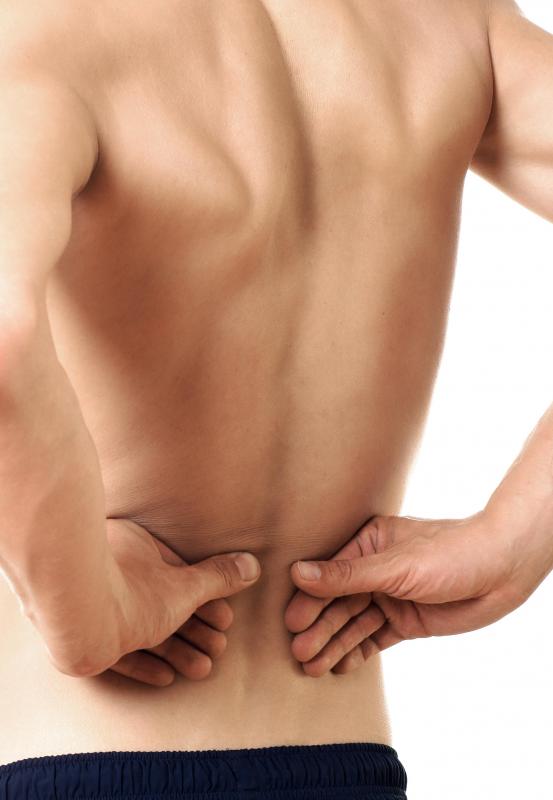At TheHealthBoard, we're committed to delivering accurate, trustworthy information. Our expert-authored content is rigorously fact-checked and sourced from credible authorities. Discover how we uphold the highest standards in providing you with reliable knowledge.
What is the Lumbosacral Spine?
The lumbosacral spine is that section of the backbone which lies around the level of the lower back and hips. Within the spine, an individual bone is known as a vertebra, plural vertebrae. Vertebrae are generally divided into five different types and, from the top to the bottom of the spine, these are: cervical, thoracic, lumbar, sacral and coccygeal. Five vertebrae form the upper, or lumbar, part of the lumbosacral spine and five vertebrae fuse together to make up the lower region, called the sacrum, which connects to the hip bones. Lumbosacral spine problems are a common source of lower back pain.
Lumbar vertebrae are large, and the main body of each bone is approximately kidney-shaped. A pair of cylindrical projections juts backward from the main body to form an arch, the top of which is made up of a couple of flattened pieces of bone. Together, the arches of all the vertebrae form a passageway known as the spinal canal, which the spinal cord runs through, from the brain all the way down to the first lumbar vertebra. The spinal cord is composed of 31 pairs of spinal nerves carrying messages between the brain and the body. Nerves branch off through holes between the vertebrae at different levels to serve various regions of the body.

Between the bodies of the lumbar vertebrae are shock-absorbing pads, known as intervertebral disks. The disks have enough elasticity to allow for the spine to move flexibly and each consists of a tough fibrous outer layer and a soft, gelatinous inner. Disks between lumbar vertebrae are relatively thick, as this is one of the most mobile regions of the spine. Sometimes, due to sudden force acting on the spine, one of the disks can prolapse, often known as a herniated or "slipped" disk. When this happens, the outer layer ruptures and the soft inner bulges through, causing sudden pain in the back.

The sacrum is composed of five vertebrae, which are fused together to make a triangular bone. Where the lowest lumbar vertebra and the sacrum join, there is a great potential for damage to occur, because this part of the lumbosacral spine is subject to a lot of twisting movements that put pressure on the joint. In fact, together with the joint between the fourth and fifth lumbar vertebrae, this is the most common place for disk prolapses. Sometimes the protruding disk presses on the spinal nerves that supply the leg and foot, causing what is known as referred pain to be felt in those areas.

Causes of a prolapsed disk can vary from a simple sneeze to lifting heavy objects awkwardly. Most cases resolve over time with a combination of painkillers and a policy of keeping as active as possible. Rarely, if symptoms do not improve after a number of weeks, referral to an orthopedics specialist may be required, and surgery might be carried out to repair the disk.
AS FEATURED ON:
AS FEATURED ON:













Discuss this Article
Post your comments